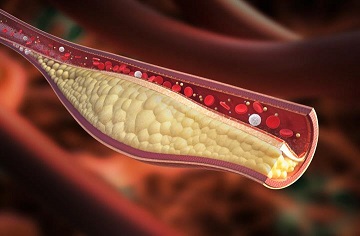
Globally, deaths arising from raised cholesterol levels reads at 2.6 million and this is sad. What’s sadder is the fact that about 10% of these people didn’t realize they have it; even the ones still alive.
Cholesterol might either be termed good or bad and many factors can influence the levels of cholesterol in your blood especially genetics.
Apart from lifestyle, diet and exercise, genetics could be a risk factor for increased cholesterol levels. If a family member has high cholesterol levels, there is every tendency you might have it especially if you don’t pay attention to lifestyle matters.
This phenomenon is termed “familial” since it runs in a family.
SOME FACTS ABOUT FAMILIAL HYPERCHOLESTEROLAEMIA
– 1 person in every 500 persons has it
– Doesn’t have symptoms, but these signs like deposits of cholesterol in skin and tendons could be notice
– Only 10%-20% of people with it know they have it
– Individuals with familial hypercholesterolaemia will pass it on to their children
IS THERE A DIFFERENCE BETWEEN FAMILIAL HYPERCHOLESTEROLAEMIA AND NORMAL HYPERCHOLESTEROLAEMIA?
If high levels of cholesterol occur in any relative of yours, such as a parent, sibling, or grandparent, you’re more likely to have it yourself. This occurrence is totally due to the passing on of genes from parents to children that increase levels of cholesterol in the blood.
Familial hypercholesterolaemia is more like an inherited form of hypercholesterolaemia. People with this type of conditions normally would have high cholesterol levels even with a lifestyle modification. Simply because they don’t have the capacity to regulate their cholesterol levels as other individuals.
There is every tendency that people with familial hypercholesterolaemia might not be able to control their cholesterol levels with just diet and exercise alone, but with medications too.
You should also note that not everyone with a high risk of developing high cholesterol actually has their cholesterol levels sky rocketing.
HOW DO I KNOW IF I HAVE FAMILIAL HYPERCHOLESTEROLAEMIA
One of the major ways to ascertain if you have high cholesterol levels especially if it’s a familial case is through a lipid screening test. This measures the amount of cholesterol in your blood.
Ideally, signs to look out for in adults are cholesterol levels above 190mg/dl and levels above 160mg/dl in children.
In addition, your doctor might help detect physical signs, which might not be common to everyone. These signs includes:
– Bumps or lumps around your knees, knuckles, or elbows
– Swollen or painful Achilles tendon
– Yellowish areas around your eyes
– A whitish grey colour in the shape of a half-moon on the outside of your cornea
WHAT CAUSES FAMILIAL HYPERCHOLESTEROLAEMIA?
This type of cholesterolaemia is a genetic one meaning it is hereditary and is caused by a defect on chromosome 19.
Your body finds it difficult to remove LDL cholesterol from the body making it easy for the narrowing of vessels which might possibly lead to atherosclerosis. You just need to get an abnormal gene from one family member to get this disease.
WHAT ARE THE RISK FACTORS AND HOW DO I MANAGE THEM?
1. OBESITY OR HIGH WAIST CIRCUMFERENCE: Both obesity and a high waist circumference can increase your risk for high cholesterol.
Obesity is defined as a body mass index (BMI) of 30 or higher, while a high waist circumference is 40 or more inches for men and 35 or more inches for women.
If you have a family history of hypercholesterolaemia, then you should be careful so fat wont be unevenly distributed in your body. When fat accumulates in only one part of the body, especially in the abdominal region, it can lead to an increased risk of developing hypercholesterolaemia and other cardiovascular complications.
2. ELEVATED BLOOD SUGAR
As someone with a family history of hypercholesterolaemia, you should also be aware of your glucose levels as high levels of glucose can increase LDL cholesterol and decrease HDL cholesterol, damage the lining of arteries and also increase your risk of fatty deposits building up in your arteries.
Lifestyle choices, like diets high in soda, candy, or other foods containing large amounts of sugar, can also contribute to high blood sugar levels.
Reducing your intake of these things that contribute to an increased glucose level is key to reducing the risks of high cholesterol levels. An increased fibre intake of at least 30-35g of fibre daily would help to keep glucose levels in check.
3. LIFESTYLE FACTORS
If you have a family history of high cholesterol, you should consider some modifications to your lifestyle as it totally affects your chances to also get the disease. Diet, exercise and social vices are risk factors associated with high cholesterol. They can be controlled by modifying your lifestyle.
– Eating a diet high in saturated and trans fats can increase your cholesterol levels. These highlighted foods should be taken away from your diet totally or restricted to the barest minimum if you have a history of high cholesterol in the family.
• red meat
• full-fat milk and yogurt
• fried foods
• highly processed sweets
More so, adding foods that are cholesterol reducing would help reduce the risks of developing high cholesterol. Foods like nuts, beans, whole grains, fruits, vegetables, green vegetables, lentils, oatmeal, whole grain breads, low-fat dairy, low-fat meats, such as poultry are helpful.
– Exercise has the tendency to help increase your HDL cholesterol and decrease your LDL cholesterol. If you can aim at 150 minutes of moderate to intense aerobic exercise weekly, then you’re on journey to increasing you HDL levels which helps to reduce risk for developing high cholesterol and other coronary diseases.
If you just want to start, you can try out walking a distance first before doing other types of exercise so as not to get fagged out easily.
– Tobacco Smoking damages the wall of your blood vessels and is detrimental to your heart health. This makes it more likely for fat deposits to build up, thereby increasing your risk of high cholesterol levels.
CONCLUSION
Apart from other risk factors, genetics is a major risk factor related to high cholesterol levels. It is very important to be aware of this condition especially if it runs in your family and also aware of measures to curb its progression.
SOURCES
1. https://www.healthline.com/health/high-cholesterol/is-high-cholesterol-hereditary#outlook
2. https://www.health.harvard.edu/heart-health/when-very-high-cholesterol-runs-in-the-family-
3. https://medlineplus.gov/ency/article/000392.htm#:~:text=Familial%20hypercholesterolemia%20is%20a%20genetic,of%20LDL%20in%20the%20blood.
4. https://www.cdc.gov/cholesterol/facts.htm



